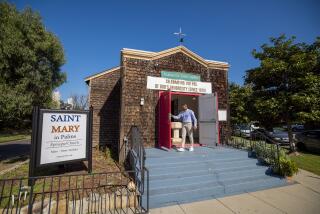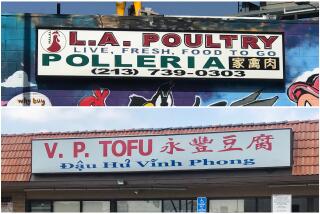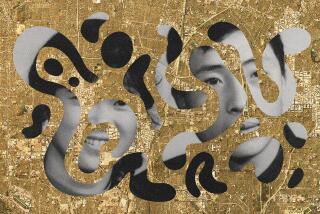Islamic Center Outgrowing Lomita Base
Outside a small, converted house in Lomita, a group of Muslim faithful wait for the sun to inch past its zenith, signaling the time for Friday jumâa prayers.
As the ancient Arabic call to prayer is broadcast over a public address system, conversations grind to a halt.
Basima Abdelkarim, a 17-year-old Palestinian whose family moved to Torrance five years ago, adjusts the traditional hijab scarf that covers her hair, slips off her shoes and crowds into the mosque with fellow Muslims from more than a dozen countries.
By the time latecomers squeeze their cars into the parking lot, the rows of praying worshipers extend out the door.
Narrow mats are hastily rolled out into the lot so congregants outside can join the service, prostrating themselves toward faraway Mecca and touching their foreheads to the faded rugs.
Inside, Hasan Ud Din Hashmi, a Pakistani scholar of Islamic studies who immigrated to California eight years ago, leads his nearly 200-strong congregation in reciting Islamâs 1,300-year-old creed:
âI bear witness that there is no god but Allah and Muhammad is his prophet.â
Although the congregants come from places as different as Thailand and Morocco, this basic belief draws them to the Islamic Center of the South Bay each Friday.
âIslam is not different whether itâs in Saudi Arabia, Iran or here in America,â said Hashmi, recently appointed imam, or spiritual leader, of the Lomita mosque.
The mosque, which attracts Muslims from all over the South Bay, is for many an oasis of familiarity in an alien, Christian-dominated society.
Abdelkarim, who graduated from Torrance High School in June, said the center is a haven where she can socialize with other Muslims her own age and practice her religion at the same time. âWithout the mosque, my life would be empty,â she said.
A growing number of Muslim immigrants, like Abdelkarim and her family, has helped to boost membership at the Lomita mosque from 30 families in 1985 to 100 today. An additional 400 are on the centerâs mailing list.
The small building on Walnut Avenue, purchased just five years ago, is already far too cramped for its burgeoning congregation.
âWe didnât realize there would be so many Muslims coming,â said Zaffar Hassanally, a member of the board of directors and one of the centerâs founders. âWeâre out of space. Itâs packed.â
The centerâs beginnings date back to 1982, when Hassanallyâs family and a few friends starting meeting for prayers at each otherâs homes.
As the numbers grew, the group rented progressively larger rooms wherever they could--first in the Courtyard Mall in Rolling Hills Estates, then at the Torrance YMCA and finally at the Clark Stadium Community Building in Hermosa Beach. Finally, the congregation bought its Lomita property, tucked behind a 7-Eleven store that fronts Pacific Coast Highway.
âAt that point, we needed a permanent place where we could pray and also set up classrooms for the children,â said Hassanally, who moved here from Pakistan and started a real estate firm in Torrance.
Drawing on Muslim immigrants from around the world, the South Bay center is marked by tremendous ethnic and cultural diversity that contributes to a unique religious atmosphere, Hashmi said.
Although there are no Kuwaitis in the congregation, Hashmi said there was concern at the mosque last Friday for fellow Muslims involved in the current conflict between Kuwait and Iraq.
The center attempts to strip away cultural influences in its practice of Islam and concentrate instead on elements common to all Muslims, said Hashmi, who taught religion for 25 years in Pakistan before moving to California to study Islamic texts at UCLA. âFrom a religious point of view, this is good because we focus on basic fundamentals.â
A distinctively American brand of Islam emerges in which common fundamentals prevail over sectarian religious differences, Hashmi added.
Shiite immigrants from Iran and Sunni Muslims from Iraq, whose countries fought a long and bloody war fueled in part by religious differences, pray side by side in the Lomita mosque.
The growth of the Lomita center mirrors a general increase in the number of mosques in Southern California. Maher Hathout, a spokesman for the Islamic Center of Southern California, the largest mosque in Los Angeles, noted that there are 30 mosques in Los Angeles County today, compared to only two 14 years ago. There are two other mosques in the South Bay, both in Inglewood.
The increasing number of mosques is partly a result of Muslim immigration. Hathout estimated that 650,000 Muslims live in Los Angeles and Orange counties. He said, however, that the new mosques are also due to a growing desire among Muslims to openly practice their religion.
Hashmi said that Muslim immigrants, faced with American society and culture, want to keep their identity. âWhen they find Christians everywhere they want to find out more about their own religion. This is human psychology.â
Whereas many Muslims go to the Lomita mosque to preserve their identities, others are forging new ones. Sprinkled among the immigrants and first-generation Californians, who together constitute 90% to 95% of the South Bay congregation, are a number of American converts drawn to Islam from a variety of backgrounds.
Some converts, like Lita Salbi, embraced Islam through marriage. Salbi, who grew up in a Methodist household in Venice, did not immediately convert when she married an Iraqi Muslim, Abdulrazzak Salbi, who sits on the centerâs board of trustees. It was only later, when the couple had their first child, that Salbi felt the need to raise her family within a single religious tradition.
Salbi said she first attended a Muslim service about eight years ago and found Islam to be âan enhancement to a faith I already had.â Among other things, it recognized the prophet status of Old and New Testament figures and resolved many of the doubts raised by her Christian faith.
âI would not take a religion just to satisfy a spouse,â Salbi said. âIt would have to be something I could feel comfortable about.â After about a year of studying the religion, Salbi began to consider herself a Muslim.
Salbi said devout Muslims do not drink alcohol, which is proscribed in the Koran. She said Muslins believe the Koran is the perfected word of God, revealed by Muhammad who is the last prophet.
There is very little formality to conversion in Islam, Salbi noted. One need only recite the simple creed.
Dawud Khalil-ullah, a director of the Lomita mosque, was attracted to Islam for different reasons. Like many African-Americans, he said, he finds a particularly resonant message in Islam.
âMany African-Americans equate Christianity with white oppression,â Khalil-ullah said. âIslam represents something different. Islam preaches and practices equality and justice for all people.â
In addition, African-Americans realize that many of their ancestors were Muslims, he said.
Regardless of how they came to Islam, congregants of the mosque uniformly mentioned tensions routinely faced by a Muslim living in a Christian society.
For women, wearing a head covering in public is just one example of how Muslim and American cultures can clash. Although Abdelkarim covers her hair during mosque services, she does not wear the hijab covering to school because she fears the reaction of other students. âRight now itâs not easy. I would be labeled as alien,â she said.
Yusef Nasouf, a 15-year-old boy born in Libya who now lives in Torrance, said his schoolmates are often curious about his religion.
â âWhy do you believe in this? Itâs dumb,â they say. I say, âItâs my religion and you have yours. You have to respect mine,â â Nasouf said.
Since the American workweek revolves around the Saturday and Sunday weekend, attending services on Friday--the day Muslims gather at the mosque for special prayers--is difficult for employees and nearly impossible for children during the school year, Hassanally said. However, he said, the mosque runs Sunday school classes for children where basic religion and Arabic are taught.
Passing on the religious tradition to children growing up in America presents the center with its greatest challenge, Abdulrazzak Salbi said.
To meet that challenge, the center would like to add a second floor to the mosque where large classrooms could be built. By eliminating classrooms and offices now on the first floor, the center could enlarge the sanctuary to cover the entire ground level. In addition, a small storage building in the parking lot would be razed to make room for more parking, Salbi said.
However, a city zoning ordinance passed last year prohibits the center from any substantial renovation or expansion. The ordinance, which rezoned lots fronting Pacific Coast Highway to create a commercial-retail zone, also included a few adjacent lots. One of them was the mosque.
Although the new zone excludes churches, the mosque is permitted to remain in its present state under a grandfather clause.
City Administrator Walker Ritter said the city does not grant use variances, so the only way to get around the zoning would be a new ordinance specifically enacted for the mosqueâs lot. The city is unlikely to do that, Ritter said.
Mosque officials are upset about the rezoning, saying it leaves them with few options. âThey had no reason to include us,â Hassanally said. âThey could have gone just with the 7-Eleven in front of us.â
City officials say they followed the borders of a previous commercial-general zone, which included the mosque property, when they defined the new zone. In addition, both city and mosque officials said the mosque raised no objections during public hearings held on the subject.
Although mosque officials acknowledge that they should have taken part in the zoning hearings, they say they perceive a common American distrust of Muslims, which they believe has disposed the city against the current expansion and some of the mosqueâs other plans in the past.
âWith a (Christian) church, they would be much more flexible, though some of it is our own fault,â Khalil-ullah said.
Ritter said Lomita welcomes churches of all religions and has not discriminated against the mosque in any fashion.
Hassanally, who heads a committee to expand the center and has dealt with city officials in the past to obtain municipal permits for the mosque, said he felt some discrimination in his dealings with the city. âItâs not overt, but I think it has some bearing,â Hassanally said.
As an example, Hassanally and other congregants recalled an incident last year when the city forced the mosque to take down a sign visible from Pacific Coast Highway.
The mosque in 1988 purchased a small strip of land that connects the original plot to the highway and is used for extra parking. The Planning Commission asked the mosque to remove a sign on this property which bore just the name of the center.
âI think just the words âIslamic Centerâ are strange to them,â Abdulrazzak Salbi said.
City Planner Richard Kawasaki said the Planning Commission rejected the sign âmainly because they didnât need it. Their main address is on Walnut. It would have created traffic problems and confusion.â
Kawasaki said the law does not specifically prohibit the sign but allows the commission discretionary power to review roadside signs for appropriateness of size, wording and placement.
Despite being rebuffed by the city on the sign, Hassanally said he intends to file an application for the second-floor expansion. However, the city planning office has told him the request would almost certainly be turned down.
The only alternatives left are to purchase adjacent parcels where expansion might be permissible or to sell the property and move elsewhere, Hassanally said.
But congregants said they prefer to stay. Two years ago, the mosque paid off the mortgage on the main property and then invested $285,000 to buy the parking strip off Pacific Coast Highway with the intention of expanding.
âWeâve grown used to Lomita,â Abdulrazzak Salbi said. âItâs close to the freeways and very convenient. In fact many Muslims live in the apartment building next door. . . . Itâs home to us.â
More to Read
Sign up for Essential California
The most important California stories and recommendations in your inbox every morning.
You may occasionally receive promotional content from the Los Angeles Times.










